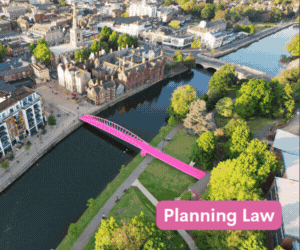The territory between the aim to permit and local authority decision-making
- Details
A district judge’s recent dismissal of a licensing appeal for an adult gaming centre will be of interest to both local authority decision-makers and premises operators, write Jeremy Phillips KC and Leo Charalambides.
On the 6th November 2023 Sheffield City Council refused an application made by Royal Amusements for a premises licence for an Adult Gaming Centre (“AGC”) at 9 Fargate, Sheffield S1 2HD.
The Applicant duly appealed. The appeal was heard over two days in the Sheffield Magistrates’ Court on the 17th October and 3rd December, 2024 by District Judge Spruce. Judgment was given on the 24th February, 2025 when the appeal was dismissed the District Judge, who said that he was [109] ‘completely satisfied that the Licensing Sub-Committee approached its decision in a way which is entirely consistent with the established law and guidance.’
The District Judge acknowledged that the dispute in the appeal lay in the application of the relevant legal principles and guidance. He stated that [54] ‘There is a clear an (sic) obvious tension between the permissive regime, and the risks which the permissive regime creates in terms of gambling harms, identified at a local level.’
The Appellant placed a heavy emphasis upon section 153(1) of the Gambling Act 2005, specifically the permissive nature of the gambling legislation – a licensing authority shall aim to permit the use of premises for gambling. If there are identified issues in terms of the licensing objectives, then the obvious remedy is to impose suitable conditions upon the premises licence to meet those concerns [49].
The position of Sheffield City Council was that it was this particular locality which was of relevance to the grant or refusal of the premises licence. It argued that the ‘harms’ envisaged by the licensing objectives were far wider than those which can be observed on, or at the door of the premises. Conditions on a premises licence can be imposed to regulate what goes on inside and, to a certain extent, who comes in. However, there are no conditions which could regulate the gambling harms which extend beyond the premises. Furthermore, there were invisible harms and unidentified vulnerabilities which could not be detected by staff or even the best regulatory measures [51]. The Director of Public Health accepted that he could give no specific examples of individuals harmed and accepted that it was not possible to map harm back to particular premises [70].
The Appellant argued that “all city centres are the same” relying on their operation of AGC’s in other towns and cities of West Yorkshire. The District Judge found that Sheffield’s SLP put the Appellant on notice that there was an expectation that different parts of its locality will be dealt with differently [77]. In his judgment the District Judge found that the contention by the Appellant all city centres are the same was ‘discredited’. The District Judge found that ‘The permissive approach articulated in Section 153 Gambling Act 2005 is manifestly subject to those matters set out in s.153(1)(a)-(d), the relevant codes, guidance and local authority statement of principles, when attempting to assess whether a grant or a premises licence is reasonably consistent with the licensing objectives. All of those policy and guidance documents draw attention to the need for local authorities to identify, set out and manage local issues priorities and concerns. It begs the question; What is the purpose of local area risk assessments if they are to be discounted and dismissed under the weight of the permissive regime? [88]’ The District Judge accepts that the aim to permit requirement does not prevent the refusal of licences to minimise harm [85] – the permissive regime stops short of being mandatory. He recorded that he had “ .. good knowledge of the location of the proposed AGC, with lived experience of how children and young people frequent and interact with the area” [65], going on to acknowledge that whilst he accepted “ .. there is no direct evidence to link the Royal Amusements venture with specific problems, there is nothing which undermines what Greg Fell reports in relation to gambling-related harm as a growing public health concern.” [71]. Subsequently he notes that the last of the three local area risk assessments (LARA) undertaken by the Appellant undermined its “submission that there was no evidence to conclude that the Fargate site had a “unique character”” [79].
The District Judge applied the Gambling Commission's Guidance to Local Authorities (para 1.7) which confirmed the position that “licensing authorities are better placed to understand and manage local issues.” He observed that ‘This also brings section 153 into sharper focus with the words “in so far as the authority think [it will be in accordance with (a) – (d)” [86]’, concluding [91] ‘Therefore, when the Appellant complains that the Local Authority did not have the latitude to make the decision that it did; and further, that the Local Authority cannot be the sole arbiter of managing harm, I am forced to ask the question, ‘Who else is to be the guardian of it?’ Who else is to be the safeguarder or potential and prospective harms, if it is not the local authority?
Although this is a Magistrates’ Court decision which recognises that the site in question had a “unique character” it provides a detailed and well-reasoned and practical application – on the facts of this case – of the s 153 principles exploring the territory between aim to permit and local authority decision-making. The decision requires careful reading demonstrating:
- the importance of identifying the relevant locality of an application and the particular risks therein;
- the role of a proper local area risk assessment (“LARA”), the status of the Statement of Licensing Policy and the observations of Council Officers in assessing and recognising specific location area vulnerabilities;
- the potential pitfalls of relying upon generic local area risk assessments and evidential snap-shots by external experts;
And crucially the acceptance by the court of the wide definition of vulnerable person and gambling harms:
‘… the Appellant points to. A record of good operations and robust set of conditions to be applied at the door and interior of the proposed premises. However, that approach fails to recognise the bigger picture of the proliferation of gambling harms within an area specific location. This is despite the fact that the Appellant now acknowledges – through its updated LARA that these risks are real. Recognising that those real risks are often hidden, intangible and invisible to traditional regulation, it is simply not possible to identify any conditions on the premises licence which would or could meet those risks. [93]’
A careful consideration of this judgment may be of interest to those that advise operators of gambling premises and local authority decision-makers.
Jeremy Phillips KC of Francis Taylor Building acted for Royal Amusements. Leo Charalambides, also of FTB, acted for Sheffield City Council.
Antisocial Behaviour Legal Officer
Regulatory/Litigation Lawyer
Solicitor - Litigation
Locums
Poll
18-03-2026 1:00 pm
01-07-2026 11:00 am



























